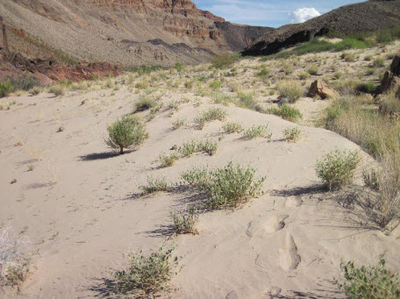Difference between revisions of "Aeolian Sand Transport"
From Glen Canyon Dam AMP
Cellsworth (Talk | contribs) |
Cellsworth (Talk | contribs) |
||
| Line 100: | Line 100: | ||
'''2011''' | '''2011''' | ||
*[http://www.usbr.gov/uc/rm/amp/amwg/mtgs/11aug24/Attach_06.pdf Bigger sand bars during the windy season in spring provide a source area for sand to blow upslope to cover some archeological sites] | *[http://www.usbr.gov/uc/rm/amp/amwg/mtgs/11aug24/Attach_06.pdf Bigger sand bars during the windy season in spring provide a source area for sand to blow upslope to cover some archeological sites] | ||
| + | |||
| + | '''2010''' | ||
| + | *[https://www.usbr.gov/uc/rm/amp/amwg/mtgs/10feb03/Attach_25.pdf Aeolian Reworking of Sandbars from the March 2008 Glen Canyon Dam High-Flow Experiment in Grand Canyon] | ||
|- | |- | ||
Revision as of 12:16, 6 July 2018
|
|
Aeolian Sand TransportSand can potentially help preserve archaeological features by direct burial and/or by mitigating gullying and other erosion. Sand can be deposited on archaeological features or within gullies via fluvial (river) or aeolian (wind) deposition. Most archaeological sites are above the highest contemporary river stage, so aeolian deposition is the most likely mechanism for preservation and/or erosion mitigation. River-sourced sand deposition is a time-dependent process, and the outer limit of that process may extend for many years after any individual HFE. Additionally, HFEs with targeted vegetation removal could produce a net sediment surplus at some sites. [1] |
| --- |
--- |
--- |
|---|
|


